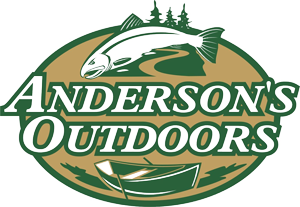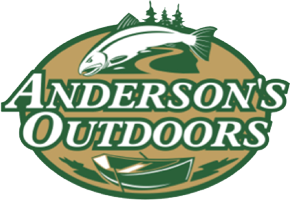What To Expect On Your Fishing Trip
Most of our trips originate out of the small Oregon coastal town of Pacific City, which is where the Nestucca River dumps into the ocean. Steelhead begin entering our Tillamook County rivers in early December. Our “early” run fish are mostly of hatchery origin and average 6-8 lbs, the peak for these hatchery fish is usually from mid Dec thru the first week of January. We also see some larger native/wild steelhead during the months of Dec-Jan. The later run is about 50/50 wild steelhead and hatchery “broodstock” steelhead. These “broodstock” fish are offspring of wild parents, most of the steelhead we see during Feb - April are 8-12 lbs (28-32”) with a fair number in the teens. The later return is the larger in total numbers as well as higher quality fish. Peak time is usually late Feb thru March, however, river conditions play a larger role than a calendar date. Regulations allow retaining 2 “fin clipped” (hatchery) steelhead per day. All wild steelhead must be released unharmed, however, I will gladly assist in capturing the moment by camera before releasing these prized fish”.
A typical day is meeting guests at the lodging in Pacific City (hotel or rental house) around 6:30 am, a short 15 minute drive to the local tackle shop to arrange shuttle and get any needed food & drinks. (Coffee and water is supplied by Anderson’s Outdoors and shore lunch can be provided at additional cost). Depending on launch locations, we are usually on the water about 7 am. Typical “full day” float trip will be off the water between 3-5 pm. I don’t look at my watch and end at 7-8 hrs everyday. Any fish retained will be cleaned or filleted at no additional cost. For guests staying overnight in Pacific City, several restaurants are close ranging from local neighborhood bars & grill, Mexican, BBQ, and an upscale brewery/restaurant on the beach with one of the best sunset locations in Oregon.
Our main techniques to catch steelhead is an active fishing method called “side drifting”. We use light action 9-9.5 foot rods with 8-10 lb line. Anglers will be casting all day, feeling the grab and setting the hook. We employ this technique either bouncing lead on the bottom or casting and watching a bobber. We use cured salmon roe, yarn balls or jigs. We also will back troll diving plugs under certain water conditions. I provide all gear, tackle and bait, however, I do not mind if an angler prefers to bring and use their own gear. Fly fishing is another option but you will need to provide your own equipment, fly fishing technique is primarily similar to nymphing using yarn balls or plastic beads. I have had some success “swinging” flies for winter steelhead but catch rate is much lower.
A typical day is meeting guests at the lodging in Pacific City (hotel or rental house) around 6:30 am, a short 15 minute drive to the local tackle shop to arrange shuttle and get any needed food & drinks. (Coffee and water is supplied by Anderson’s Outdoors and shore lunch can be provided at additional cost). Depending on launch locations, we are usually on the water about 7 am. Typical “full day” float trip will be off the water between 3-5 pm. I don’t look at my watch and end at 7-8 hrs everyday. Any fish retained will be cleaned or filleted at no additional cost. For guests staying overnight in Pacific City, several restaurants are close ranging from local neighborhood bars & grill, Mexican, BBQ, and an upscale brewery/restaurant on the beach with one of the best sunset locations in Oregon.
Our main techniques to catch steelhead is an active fishing method called “side drifting”. We use light action 9-9.5 foot rods with 8-10 lb line. Anglers will be casting all day, feeling the grab and setting the hook. We employ this technique either bouncing lead on the bottom or casting and watching a bobber. We use cured salmon roe, yarn balls or jigs. We also will back troll diving plugs under certain water conditions. I provide all gear, tackle and bait, however, I do not mind if an angler prefers to bring and use their own gear. Fly fishing is another option but you will need to provide your own equipment, fly fishing technique is primarily similar to nymphing using yarn balls or plastic beads. I have had some success “swinging” flies for winter steelhead but catch rate is much lower.
Fish We Catch
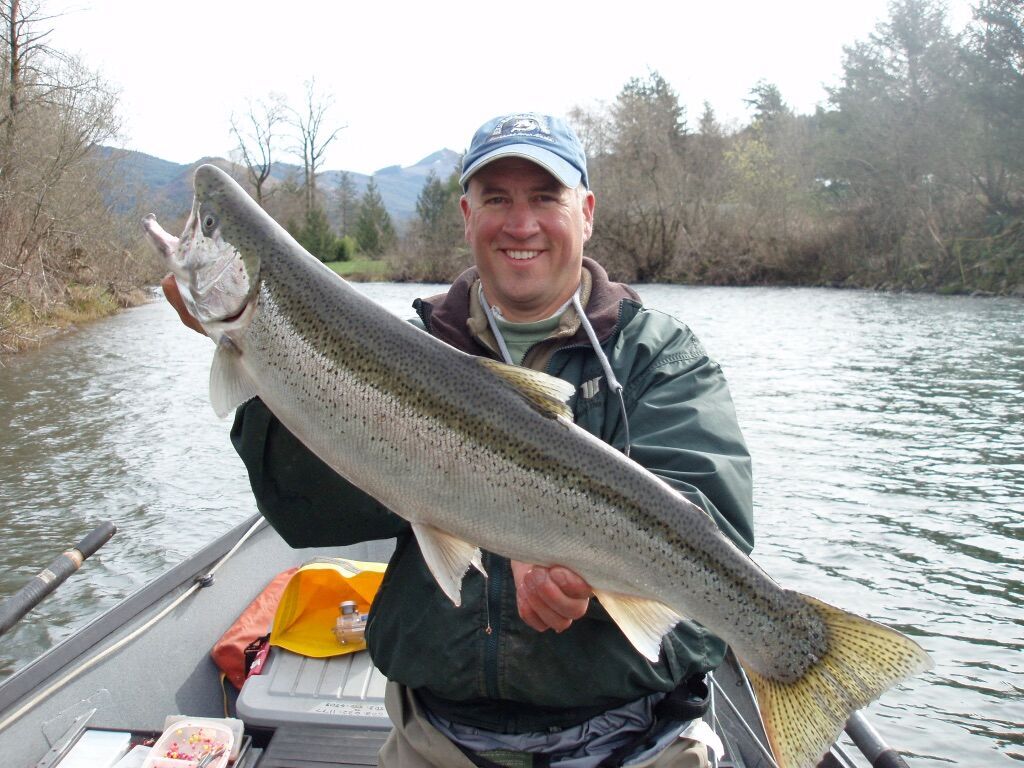
Steelhead

Salmon
Oregon Steelhead Fishing
Oregon is home to a strain of Rainbow trout that migrate to the ocean and return to our rivers as 6-20+ lb beauties known as "Steelhead". Steelhead can be found in local rivers year around. We start seeing winter steelhead (primarily of hatchery origin) in late November and they run well into April. Spring steelhead (primarily native fish) can be caught from December through April with the peak in March. Summer steelhead show in late March and run into October. Many agree that Oregon steelhead are one of the most exhilarating fish species to catch.
Winter steelhead are found in almost all the rivers in western Oregon. We primarily fish the Nestucca River on the north Oregon coast. We also fish several other coastal rivers as well as the Clackamas and Sandy Rivers in the Portland area. We go where the fish are, and thankfully we have lots of great choices in the area. Winter steelhead are primarily of hatchery origin, which allows our guests to keep 2 per day (state law requires the release of all wild steelhead). Light tackle is used to catch these "silver bullets". Bring rain gear and an adventure as we pursue these often elusive trophies.
Big, aggressive native Spring Steelhead enter our rivers in the late winter/spring. These awesome fish usually run over 10 lbs and strike with incredible ferocity. Due to catch and release restrictions many people ignore this fishery. It is not uncommon to see almost nobody else even during the peak of the run.
This is the time of year to shake off winter and enjoy a beautiful spring outdoor excursion. If a trophy steelhead is your goal, this is the time (20+ pounders are caught annually).
Summer steelhead are usually caught while targeting other species since I am in Alaska during the majority of the run. We primarily catch "summers" in the Clackamas or Sandy rivers while fishing for Spring Chinook or Coho salmon in the Fall.
Winter steelhead are found in almost all the rivers in western Oregon. We primarily fish the Nestucca River on the north Oregon coast. We also fish several other coastal rivers as well as the Clackamas and Sandy Rivers in the Portland area. We go where the fish are, and thankfully we have lots of great choices in the area. Winter steelhead are primarily of hatchery origin, which allows our guests to keep 2 per day (state law requires the release of all wild steelhead). Light tackle is used to catch these "silver bullets". Bring rain gear and an adventure as we pursue these often elusive trophies.
Big, aggressive native Spring Steelhead enter our rivers in the late winter/spring. These awesome fish usually run over 10 lbs and strike with incredible ferocity. Due to catch and release restrictions many people ignore this fishery. It is not uncommon to see almost nobody else even during the peak of the run.
This is the time of year to shake off winter and enjoy a beautiful spring outdoor excursion. If a trophy steelhead is your goal, this is the time (20+ pounders are caught annually).
Summer steelhead are usually caught while targeting other species since I am in Alaska during the majority of the run. We primarily catch "summers" in the Clackamas or Sandy rivers while fishing for Spring Chinook or Coho salmon in the Fall.
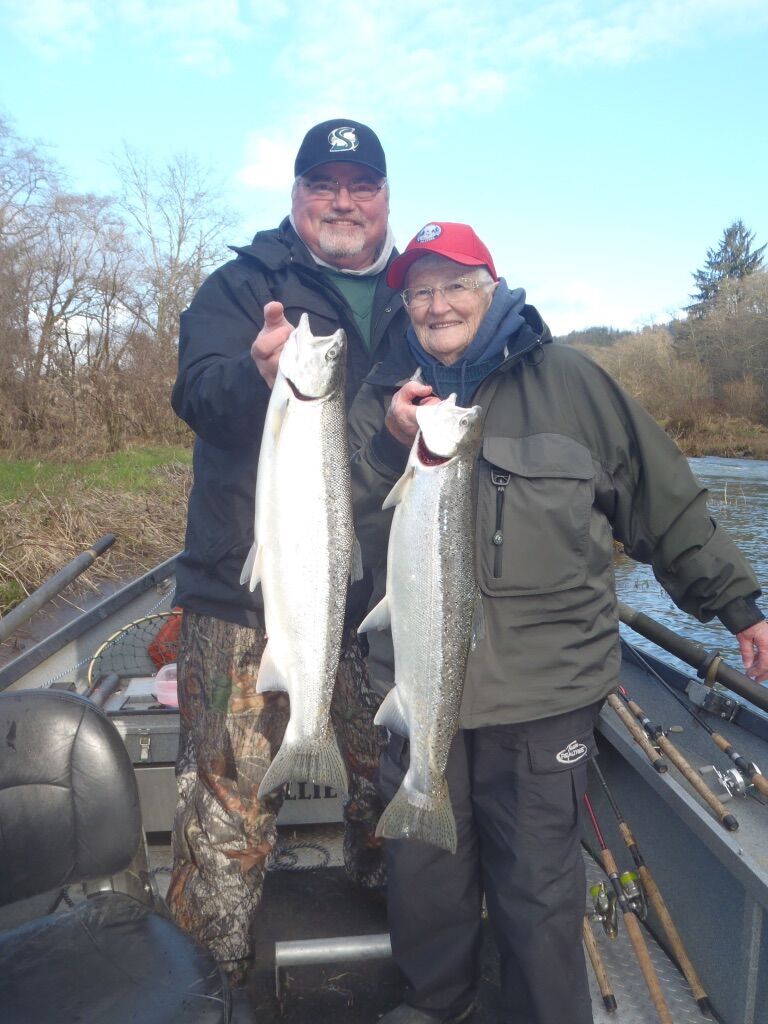
Salmon Fishing
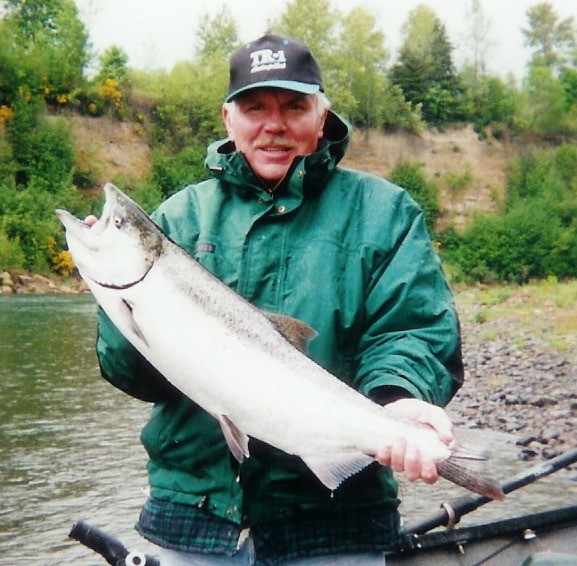
Spring Chinook
Oregon rivers are home to a variety of fish but the "king" of them all is the Chinook (or King) Salmon. These salmon enter our rivers in the Spring and Fall. If your impression of a salmon charter is a crowded boat using short and stout rods you will be pleasantly surprised. We fish out of a McKenzie style drift boat and usually limit it to two guests and a guide (We can accommodate up to three guests). Gear used is stout enough to handle the fish but light enough to enjoy the fight! Do you think you’re up to the challenge?
Spring Chinook or "springers", as they’re locally called, begin entering the Columbia River in February, beginning an upstream migration that will last several months over several hundred river miles. Because of this spawning trait, springers have a characteristically high fat and oil content that helps to sustain them over their migration. This high fat content makes them one of the finest eating fish on the planet as well as an exceptionally strong fighter.
We spend most of our time fishing springers in the Clackamas and Sandy rivers, both are Columbia basin tributaries. Beginning in April, the numbers increase daily reaching a crescendo in May and June. Spring Chinook range in size from 12 to 30+ lbs., with most fish tipping the scales in the middle and upper teens. This is a genuinely special trip. The opportunity to experience the unbridled thrill of one of these powerful fish on the business-end of your line is like no other fishing experience.
Spring Chinook or "springers", as they’re locally called, begin entering the Columbia River in February, beginning an upstream migration that will last several months over several hundred river miles. Because of this spawning trait, springers have a characteristically high fat and oil content that helps to sustain them over their migration. This high fat content makes them one of the finest eating fish on the planet as well as an exceptionally strong fighter.
We spend most of our time fishing springers in the Clackamas and Sandy rivers, both are Columbia basin tributaries. Beginning in April, the numbers increase daily reaching a crescendo in May and June. Spring Chinook range in size from 12 to 30+ lbs., with most fish tipping the scales in the middle and upper teens. This is a genuinely special trip. The opportunity to experience the unbridled thrill of one of these powerful fish on the business-end of your line is like no other fishing experience.
Fall Chinook Fishing
Fall Chinook begin entering Oregon’s coastal bays in late July (Season opens Aug. 1st on many rivers systems) and continues through the end of December, usually peaking in October. These are the largest salmon found in Oregon. Average size running 25-35 lbs. with an occasional fish into the 60 pound range caught every year. I spend the lion’s share of my time on the Nestucca River and several other smaller coastal rivers and tidewater sections of the bays. Fishing the lower sections of the rivers ensures the catch of ocean fresh, hard fighting salmon and the Oregon coast in the Fall is spectacular.
Oregon’s Fall Chinook are exceptionally strong fish characterized by a stocky frame that’s ideally designed to generate spectacularly powerful runs when hooked.
Oregon’s Fall Chinook are exceptionally strong fish characterized by a stocky frame that’s ideally designed to generate spectacularly powerful runs when hooked.

